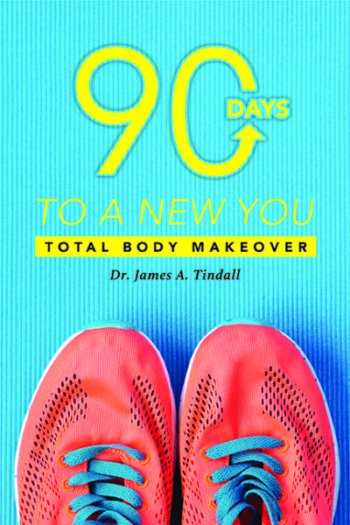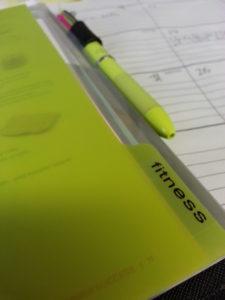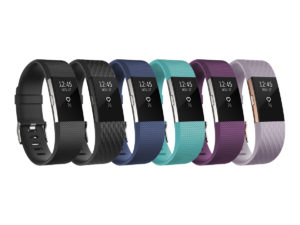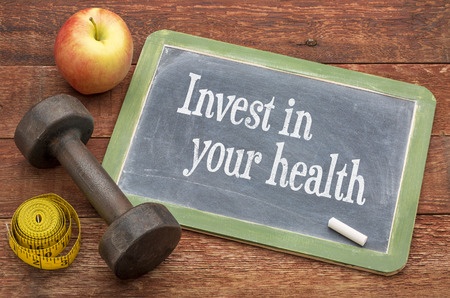Years ago, I enrolled in a time management course with Franklin-Covey. It was probably the most valuable course that I have ever taken, despite my four college degrees. I was already good at project management and related areas, but something just seemed to be missing. Have you ever found yourself running out of time? Especially when you’re really trying hard to keep your New Year’s resolution and get your body in shape and shed those pounds. If you have, you’re not alone. So many of us want to get going and just simply do not seem to be able to stay on track.
Advertisement: Amazon (click on photo for more info)

So, first things first, go out this week and get a yearly planner, the kind that you can write things down in every day and in terms of fitness, one that you can keep track of your program and successes. There are some great companies out there that have some wonderful time management tools and after all, getting healthy and fit is in a big way, all about time management. Take a look at Franklin-Covey, Levenger, Day Timer, At-a-Glance and others. Find a time management and planner system that works for you.
What do I want you to do with this time management system? I want you to utilize it to help you plan your day and stay on track, especially with your fitness and health goals. Don’t give me the excuse next year that you ran out of time. It’s not that we do not have enough time, it is that we do not plan or use it as well as we could. Once you have your time-management system, make a list of “things to do today.” This is what I call my “TD” or ‘to do’ today list. Let’s look at lists from Susan and Tom.
Susan’s To Do list for Today
1. Get kids off to school
2. Go to work
3. Dentist appointment
4. Pick up kids
5. Cook dinner
6. Workout
7. Relax and read some work material
8. Call Mom
Tom’s To Do list for Today
1. Pick up dry cleaning
2. Meeting with boss
3. Workout
4. Dinner
5. Lunch with Susan
6. Get groceries
7. Finish writing assignment due in three days
8. Call to set appointment for physical
Advertisement: Amazon (click on photo for more info)

The lists that both Susan and Tom wrote down are typical for many people. Is there any difference between the two lists? At first glance, you may not see a difference, but if you look closely, Susan wrote her list basically in the order she would be doing each task. The one question would be whether she would be able to do a workout after making dinner. Hey, it could happen! Tom’s list on the other hand, appears very scattered, almost as if he’ll just get to things as they come and that the time for each will magically work itself out correctly. It won’t!
Now, ask yourself if your health, wellness and fitness really is a priority. If they are, you need to prioritize every daily list. Following is a good way to do that:
1. ‘A’ priorities – these are items that must be done today.
2. ‘B’ priorities – items you’d like to do today but can be postponed until tomorrow if time becomes a real issue.
3. ‘C’ priorities – can be done anytime and any day of the week, such as a casual phone call.
Obviously, you’ll likely have multiple A, B, and C priorities. So, write down your list, number each priority as most to least important and check each priority off as you complete it.
Let’s do Tom’s list since it is more scattered. And, we know that Tom is a big fitness buff because he gets up early every morning and gets a workout done as soon as he can on most days. But, since his workout is a priority, lets make it ‘the’ major priority each day – ‘A1.’ Why? Because since he gets up early, it’s a relatively easy task to complete before the workday begins.
Tom’s re-ordered list
B.. Pick up dry cleaning
A.. Meeting with boss
A.. Workout
A.. Dinner
B.. Lunch with Susan
C.. Get groceries
B.. Finish writing assignment due in three days
C.. Call to set appointment for physical
Note that now, Tom has multiple A, B, and C priorities so, let’s number them from most to least important in each priority category.
Tom’s prioritized list
B3 Pick up dry cleaning
A2 Meeting with boss
A1 Workout
A3 Dinner
B1 Lunch with Susan
C1 Get groceries
B2 Finish writing assignment due in three days
C2 Call to set appointment for physical
Advertisement: Levenger (click on photo for more info)

Let’s look at how Tom prioritized his list. Because he gets up so early, the workout became the first priority both because it’s very important to Tom and he can do it before his workday starts. Getting healthy and staying healthy should also be your first priority.
The second ‘A’ priority is a meeting with the boss and later in the day, dinner because Tom is single and uses dinner time to read and catch up on other work and personal projects. Thus, dinner may not be a ‘A’ priority for you.
The ‘B’ priorities are a little easier with lunch with Susan being number one in this category following by his writing assignment. Note however, that the writing assignment is due in three days so, if Tom doesn’t get it done today, he still has two more days to complete it. And, if he did not get it done tomorrow, it would then become an ‘A’ priority on the last day.
The ‘C’ priorities are casual items that need to be done. A phone call to make an appointment, talk to a friend or check a progress status can be done anytime, even in the car on your way from one place to another, just do not text and make sure you have a hands-free Bluetooth available; you’ll live longer and also help someone else live longer by keeping your attention on your driving. Groceries may not be direly needed today so, that priority can be put off until tomorrow or even the weekend. The same is true of the doctor’s appointment. Scheduling it is just a phone call away, so it can be done anytime.
This is a new year so, use your time wisely and then, next year, tell me how well you did. I exhort you to make your personal health, fitness and well being and ‘A’ priority so that it always comes first. You’ll be glad you did and it’ll become a habit.
Now that you know how to manage your time more wisely, let’s discuss the basic steps to get back into shape and on that fitness workout horse again. I’ll list them below, but in simplistic terms the steps are simply getting started and slowly increasing your intensity.
Beginning a good fitness program may be one of the best things you can do for your health and longevity. Physical activity can reduce your risk of chronic disease, improve your balance, and coordination, help you lose weight, and improve sleep habits and self-esteem. Best of all, you can start your program with five easy steps. What are these steps? They include assessing your fitness level, designing your fitness program, assembling your fitness equipment, getting started, and monitoring your progress.
1. Assess your fitness level
Before you begin, check with your physician to ensure there are no health problems and so that you’ll feel more comfortable while you begin. All of us likely have some idea of how fit we are but assessing and recording baseline fitness scores can give you a benchmark that you can use to judge future performance by as you progress from day to day. Let’s assess your aerobic and muscular fitness, flexibility, and body composition. To do this, record the following about your performance:
• Pulse rate – both before and immediately after walking 1 mile. If you cannot do one mile, try ½ mile;
• Record the time it takes you to walk ½ or 1 mile. If that is not doable, record the time for ¼ mile. If you are fit, record this for 1.5 miles;
• Perform as many sit ups and pushups you can do in one minute. If you cannot do full pushup and sit-ups, try modifying them to incline pushups and crunches and record that number;
• Sit flat on the floor with legs/feet out in front of you – measure how far you can reach while bending forward;
• Measure your waist circumference, just above your hipbones; and
• Record your body mass index.
2. Design your fitness program
There are two things that make it difficult for people to get into a fitness program. First, they try to add more exercises than they can do in an allotted time and second, by doing so they generally get very sore because they have not exercised in a while. Avoid doing this and you’ll get off to a great start. You need a plan. Design an exercise program, but keep in mind the following:
• Consider your fitness goals. Are you starting a fitness program to help lose weight or, do you have another motivation, such as preparing for a marathon? Make your goals clear to help you gauge progress and stay motivated;
• Create a balanced routine
It is recommended that you get 150 minutes of moderate aerobic activity or 75 minutes of vigorous aerobic activity per week, or a combination of moderate and vigorous activity;
As an example, aim for about 30 minutes of aerobic exercise on most days of the week. Also, incorporate strength training of all the major muscle groups into a fitness routine at least two days a week;
• Start low and progress slowly. If you’re just beginning to exercise or haven’t done so for a while, start cautiously and progress slowly. The gym is there every day so, build slowly, especially in terms of weight load in strength-training exercises. Design your program so that it gradually improves your range of motion, strength, and endurance;
• Build activity into your daily routine. The biggest challenge in fitness to finding a time to exercise that fits into your schedule. Once you find it – KEEP IT! To make it easier, schedule time to exercise as you would any other appointment. Plan to watch your favorite show while walking on the treadmill, read while riding a stationary bike, or take a break to go on a walk at work;
• Plan to include different activities. Different activities (cross-training) can keep exercise boredom at bay. Cross-training using low-impact forms of activity, such as biking or water exercise, also reduces your chances of injuring or overusing one specific muscle or joint. Plan to alternate among activities that emphasize different parts of your body, such as walking, swimming and strength training.
• Allow time for recovery. Many people start exercising with frenzied zeal — working out too long or too intensely — and give up when their muscles and joints become sore or injured. Plan time between sessions for your body to rest and recover.
• Put it on paper. A written plan may encourage you to stay on track. Look at our 30-Day Express Program; it’s free and you access it on your smart phone or print it out and take it to the gym.
3. Assemble your equipment
Let’s think of this methodically. What do you need when you exercise? You likely have workout clothes of some type so, the main item is a good pair of shoes to workout in. The type you need will depend on what types of exercise you want to do such as running, biking, strength training, etc. Pick shoes designed for the activity you have in mind. For example, running shoes are lighter in weight than cross-training shoes, which are more supportive. Ask for help at your local footwear store and the sales people will be happy to guide you into the right pair.
If you plan on investing in exercise equipment, be it weights, bikes, treadmills, etc., choose equipment that’s practical, enjoyable, and most of all, easy to use. Do not buy expensive equipment without trying it out first – go to your local gym and have a go at it. With gym memberships priced low right now, you should think twice about getting your own because at about $120 per year, a standard bike or treadmill would take 5-6 years to pay off at current membership rates.
There are also many kinds of fitness devices to utilize if you plan on running, doing weight free exercises and so forth. So, consider using fitness apps for smart devices or other activity tracking devices such as Fitbit that tracks your distance, calories burned, or even monitors your heart rate.
Advertisement: FitBit (click on photo for more info)

4. Get started
You have done the first three steps, now it is time to simply get going. As you do so, be mindful of the following:
• Start slowly and progress gradually. Plan your time and give yourself plenty to warm up and cool down with easy walking or gentle stretching, especially the first week or so in your activities. Slowly speed up the pace and or increase the intensity for 10-20 without getting overly tired. As your endurance and stamina improves, gradually increase the amount of time you exercise until you reach 30 to 60 minutes of exercise most days of the week. If you’re going to compete, you’ll surpass these times.
• Split your exercise time if you need to. If you feel time starved, do not do all your exercise at one time; blend them into your daily activity by splitting apart what can be done in the gym and what can be done at the home or office. Often, short but more-frequent sessions have aerobic benefits too. Exercising in 10-minute sessions three times a day may fit into your schedule better than a single 30-minute session. And, walking stairs, pushups, sit-ups and other types of exercises can be done on the go at the office, during breaks, or at home.
• Creativity is a must. For example, it is likely that your workout routine includes various activities such as walking, bicycling, or running. Do not stop there, instead, take a weekend hike at the park or in the woods; run around the track at your local high school, or go swimming at your community center. The important thing to do is that while planning your workout program, find activities you enjoy and add them to your fitness routine.
• Listen to your body. If you feel pain (especially if it’s sharp), shortness of breath, get dizzy, feel nauseated, or something that doesn’t feel right, take a break. The symptoms are likely because you are pushing too hard.
• Be flexible. Stick to your plan, but if you don’t feel well on some days, give yourself permission to take a day off. Remember, a healthy lifestyle is about long-term persistence.
5. Monitor your progress
Once you get going and are being persistent, retake your personal fitness assessment about six weeks after you start your program and then again, every two months so that you can track your overall progress – write this down in a personal journal. You will likely notice that you need to increase the amount of time you exercise to continue improving. Or, you may be pleasantly surprised to find that you’re exercising just the right amount to meet your fitness goals.
One thing that happens to most of us is that we occasionally lose our motivation. If you lose motivation, set new goals and or try a new activity. Exercising with a friend or taking a class at a fitness center may help, too. This will help hold you accountable.
Starting an exercise program is an important decision, but it does not need to be an overwhelming one. By planning carefully and pacing yourself, you can establish a healthy habit that lasts a lifetime.
Finally, one of the big questions many have is, “How do a develop my own exercise program?” The answer is, you no longer need to, we have done that for you, to make it as easy as possible. Go to ‘My Workout’ section of the website and design your own program. However, be honest about your goals and fitness level. For example, do not click advanced when you’re really a beginner, nor do you want to click adding speed-strength exercises, when you likely do not know how to do them or are no longer in shape for them.
You’ll find it easy to develop your own program with the ‘My Workout’ tools. Best of all, you can print it out and take it to the gym with you or store on your phone. Whether you want a 1, 2, or 4-week program, you’ll find it fun and easy and, you’ll progress quickly.
Finally, we always do a free 30-day workout program called the 30-Day Express Program on the home page of this website. Simply click on it and follow the monthly, free workout. And, if you don’t like the exercises, insert ones that you enjoy more. It’s all about having fun and getting back in shape. After all, don’t you want to look good at the beach this summer? Now is the time to begin. Have a happy and healthy day and most of all, have a Happy and Prosperous New Year!







